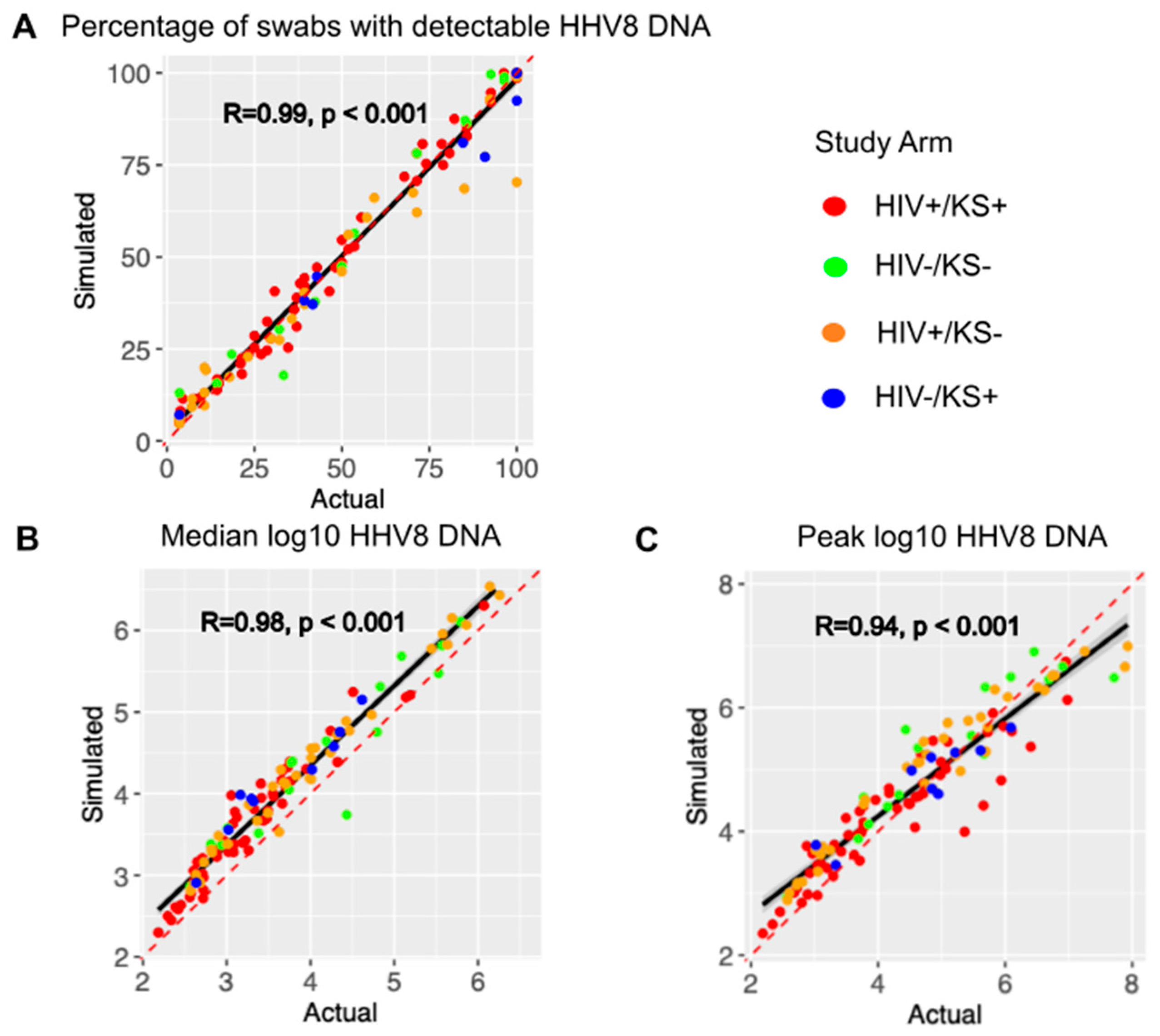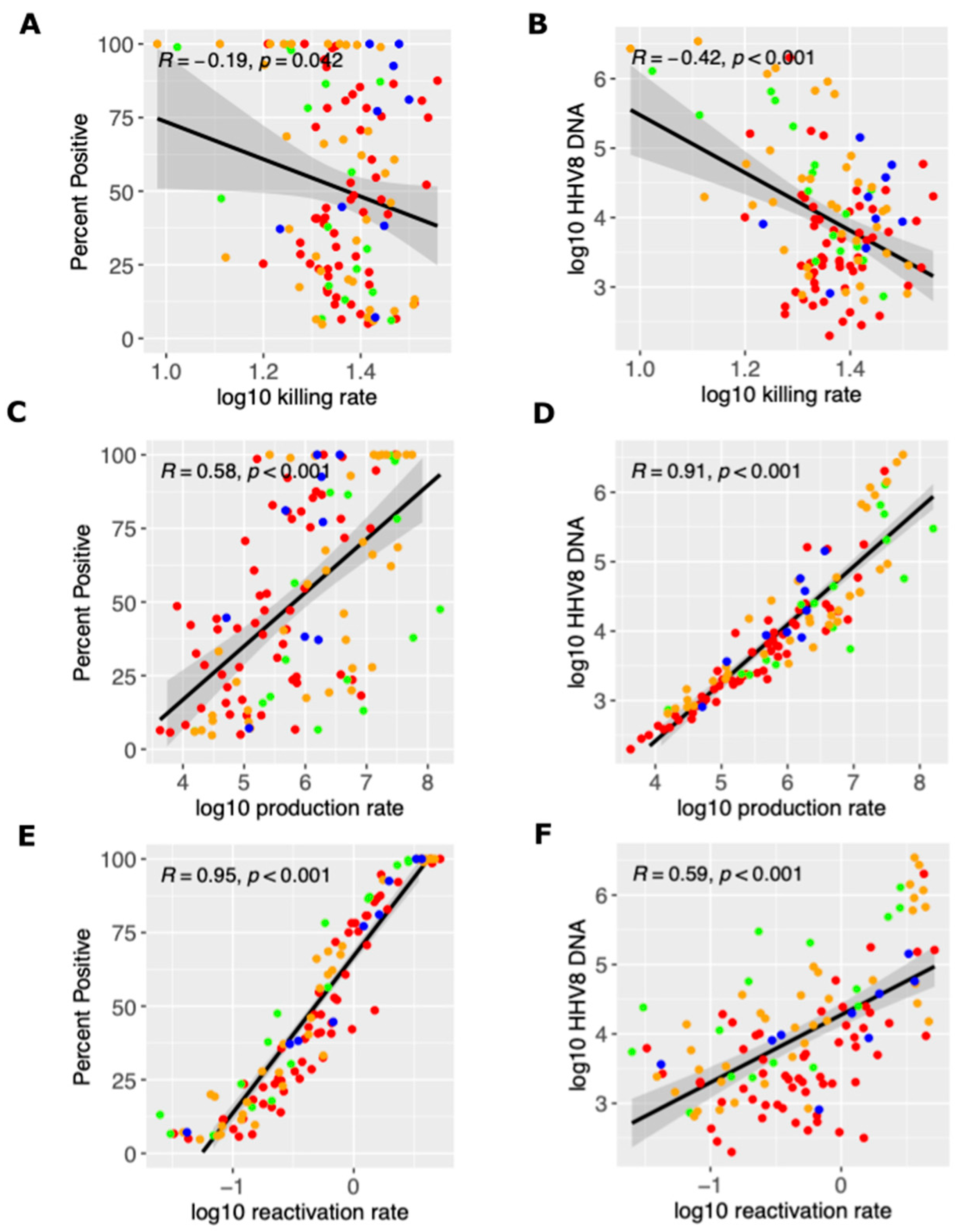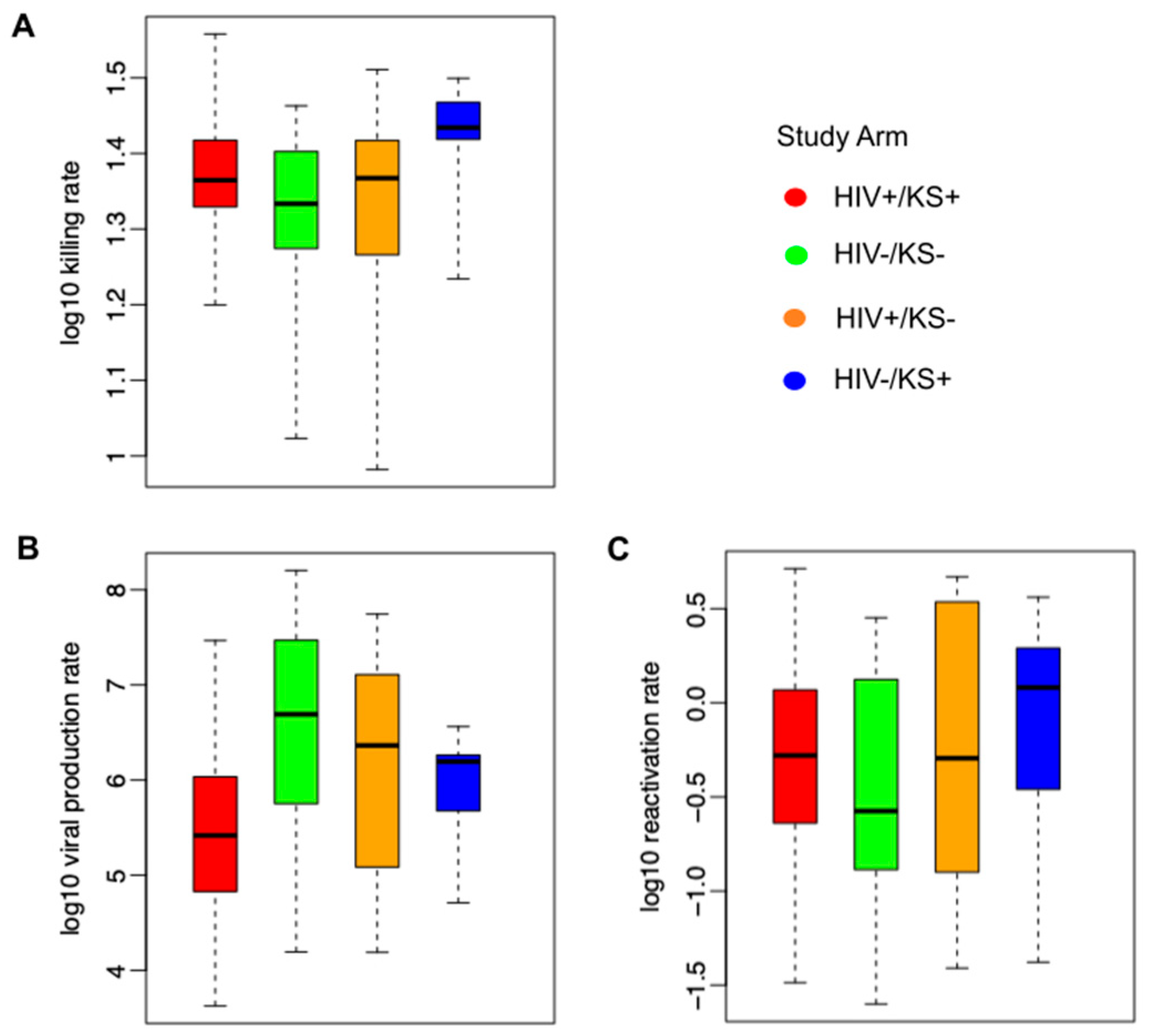Human Herpes Virus-8 Oral Shedding Heterogeneity Is Due to Varying Rates of Reactivation from Latency and Immune Containment
Abstract
1. Introduction
2. Materials and Methods
2.1. Mathematical Model of HHV-8 Oral Shedding
- Ej ⟶ Ej + 1 with rate (β × Ij) + ϕ;
- Ej ⟶ Ej − 1 with rate ε × Ej;
- Ij ⟶ Ij + 1 with rate ε × Ej;
- Ij ⟶ Ij − 1 with rate (a × Ij) − (f × Ij × Tj);
- Tj ⟶ Tj + 1 with rate α + (F(Ij) × θ × Tj);
- Tj ⟶ Tj − 1 with rate δ × Ej;
- F(Ij) = Ij/(Ij + r50);
- Vcj ⟶ Vcj + 1 with rate p × Ij;
- Vcj ⟶ Vcj − 1 with rate (a + (f × Tj)) × Vcj;
- Vej ⟶ Vej + 1 with rate (a + (f × Tj)) × Vcj;
- Vej ⟶ Vej − 1 with rate c × Vej;
- Vetot = Ve1 + Ve2 + … +Ve240.
2.2. Cohort Data
2.3. Model Fitting
3. Results
3.1. Cohort Summary Statistics
3.2. Model Simulations Recapitulate Observed Variability in HHV-8 Shedding
3.3. Mechanistic Predictions of HHV-8 Shedding Rate and Viral Load
3.4. Parameter Ranges According to HIV and KS Status
4. Discussion
Supplementary Materials
Author Contributions
Funding
Institutional Review Board Statement
Informed Consent Statement
Data Availability Statement
Acknowledgments
Conflicts of Interest
References
- Chang, Y.; Cesarman, E.; Pessin, M.S.; Lee, F.; Culpepper, J.; Knowles, D.M.; Moore, P.S. Identification of herpesvirus-like DNA sequences in AIDS-associated Kaposi’s sarcoma. Science 1994, 266, 1865–1869. (In English) [Google Scholar] [CrossRef] [PubMed]
- Walter, P.R.; Philippe, E.; Nguemby-Mbina, C.; Chamlian, A. Kaposi’s sarcoma: Presence of herpes-type virus particles in a tumor specimen. Hum. Pathol. 1984, 15, 1145–1146. (In English) [Google Scholar] [CrossRef]
- El Zeinaty, P.; Lebbé, C.; Delyon, J. Endemic Kaposi’s Sarcoma. Cancers 2023, 15, 872. (In English) [Google Scholar] [CrossRef] [PubMed]
- Erlay, J.; Siegel, R.L.; Laversanne, M.; Soerjomataram, I.; Jemal, A.; Bray, F. Global Cancer Statistics 2020: GLOBOCAN Estimates of Incidence and Mortality Worldwide for 36 Cancers in 185 Countries. CA Cancer J. Clin. 2021, 71, 209–249. (In English) [Google Scholar] [CrossRef]
- Ignacio, R.A.B.; Goldman, J.D.; Magaret, A.S.; Selke, S.; Huang, M.-L.; Gantt, S.; Johnston, C.; Phipps, W.T.; Schiffer, J.T.; Zuckerman, R.A.; et al. Patterns of human herpesvirus-8 oral shedding among diverse cohorts of human herpesvirus-8 seropositive persons. Infect. Agents Cancer 2016, 11, 7. (In English) [Google Scholar] [CrossRef]
- Phipps, W.; Saracino, M.; Selke, S.; Huang, M.-L.; Jaoko, W.; Mandaliya, K.; Wald, A.; Casper, C.; McClelland, R.S. Oral HHV-8 replication among women in Mombasa, Kenya. J. Med. Virol. 2014, 86, 1759–1765. (In English) [Google Scholar] [CrossRef]
- Pellett, P.; Wright, D.; Engels, E.; Ablashi, D.; Dollard, S.; Forghani, B.; Glynn, S.; Goedert, J.; Jenkins, F.; Lee, T.; et al. Multicenter comparison of serologic assays and estimation of human herpesvirus 8 seroprevalence among US blood donors. Transfusion 2003, 43, 1260–1268. (In English) [Google Scholar] [CrossRef]
- Dollard, S.C.; Butler, L.M.; Jones, A.M.G.; Mermin, J.H.; Chidzonga, M.; Chipato, T.; Shiboski, C.H.; Brander, C.; Mosam, A.; Kiepiela, P.; et al. Substantial regional differences in human herpesvirus 8 seroprevalence in sub-Saharan Africa: Insights on the origin of the “Kaposi’s sarcoma belt”. Int. J. Cancer 2010, 127, 2395–2401. (In English) [Google Scholar] [CrossRef]
- Casper, C.; Krantz, E.; Selke, S.; Kuntz, S.R.; Wang, J.; Huang, M.; Pauk, J.S.; Corey, L.; Wald, A. Frequent and asymptomatic oropharyngeal shedding of human herpesvirus 8 among immunocompetent men. J. Infect. Dis. 2007, 195, 30–36. (In English) [Google Scholar] [CrossRef] [PubMed]
- Pauk, J.; Huang, M.-L.; Brodie, S.J.; Wald, A.; Koelle, D.M.; Schacker, T.; Celum, C.; Selke, S.; Corey, L. Mucosal shedding of human herpesvirus 8 in men. N. Engl. J. Med. 2000, 343, 1369–1377. (In English) [Google Scholar] [CrossRef]
- Johnston, C.; Orem, J.; Okuku, F.; Kalinaki, M.; Saracino, M.; Katongole-Mbidde, E.; Sande, M.; Ronald, A.; McAdam, K.; Huang, M.-L.; et al. Impact of HIV infection and Kaposi sarcoma on human herpesvirus-8 mucosal replication and dissemination in Uganda. PLoS ONE 2009, 4, e4222. (In English) [Google Scholar] [CrossRef]
- Hawkins, J.B.; Delgado-Eckert, E.; Thorley-Lawson, D.A.; Shapiro, M. The cycle of EBV infection explains persistence, the sizes of the infected cell populations and which come under CTL regulation. PLoS Pathog. 2013, 9, e1003685. [Google Scholar] [CrossRef]
- Hadinoto, V.; Shapiro, M.; Sun, C.C.; A Thorley-Lawson, D. The dynamics of EBV shedding implicate a central role for epithelial cells in amplifying viral output. PLOS Pathog. 2009, 5, e1000496. [Google Scholar] [CrossRef] [PubMed]
- Casper, C.; Nichols, W.G.; Huang, M.-L.; Corey, L.; Wald, A. Remission of HHV-8 and HIV-associated multicentric Castleman disease with ganciclovir treatment. Blood 2004, 103, 1632–1634. (In English) [Google Scholar] [CrossRef] [PubMed]
- Bower, M.; Newsom-Davis, T.; Naresh, K.; Merchant, S.; Lee, B.; Gazzard, B.; Stebbing, J.; Nelson, M. Clinical Features and Outcome in HIV-Associated Multicentric Castleman’s Disease. J. Clin. Oncol. 2011, 29, 2481–2486. (In English) [Google Scholar] [CrossRef]
- Dupin, N.; Diss, T.L.; Kellam, P.; Tulliez, M.; Du, M.-Q.; Sicard, D.; Weiss, R.A.; Isaacson, P.G.; Boshoff, C. HHV-8 is associated with a plasmablastic variant of Castleman disease that is linked to HHV-8–positive plasmablastic lymphoma. Blood 2000, 95, 1406–1412. (In English) [Google Scholar] [CrossRef] [PubMed]
- Castleman, B.; Iverson, L.; Menendez, V.P. Localized mediastinal lymph-node hyperplasia resembling thymoma. Cancer 1956, 9, 822–830. (In English) [Google Scholar] [CrossRef]
- Gathers, D.A.; Galloway, E.; Kelemen, K.; Rosenthal, A.; Gibson, S.E.; Munoz, J. Primary Effusion Lymphoma: A Clinicopathologic Perspective. Cancers 2022, 14, 722. (In English) [Google Scholar] [CrossRef]
- Lurain, K.; Polizzotto, M.N.; Aleman, K.; Bhutani, M.; Wyvill, K.M.; Gonçalves, P.H.; Ramaswami, R.; Marshall, V.A.; Miley, W.; Steinberg, S.M.; et al. Viral, immunologic, and clinical features of primary effusion lymphoma. Blood 2019, 133, 1753–1761. (In English) [Google Scholar] [CrossRef]
- Shannon-Lowe, C.; Rickinson, A. The Global Landscape of EBV-Associated Tumors. Front. Oncol. 2019, 9, 713. (In English) [Google Scholar] [CrossRef]
- Mercader, M.; Taddeo, B.; Panella, J.R.; Chandran, B.; Nickoloff, B.J.; Foreman, K.E. Induction of HHV-8 lytic cycle replication by inflammatory cytokines produced by HIV-1-infected T cells. Am. J. Pathol. 2000, 156, 1961–1971. (In English) [Google Scholar] [CrossRef]
- Taylor, M.M.; Chohan, B.; Lavreys, L.; Hassan, W.; Huang, M.; Corey, L.; Morrow, R.A.; Richardson, B.A.; Mandaliya, K.; Ndinya-Achola, J.; et al. Shedding of human herpesvirus 8 in oral and genital secretions from HIV-1-seropositive and -seronegative Kenyan women. J. Infect. Dis. 2004, 190, 484–488. (In English) [Google Scholar] [CrossRef]
- Perelson, A.S.; Neumann, A.U.; Markowitz, M.; Leonard, J.M.; Ho, D.D. HIV-1 dynamics in vivo: Virion clearance rate, infected cell life-span, and viral generation time. Science 1996, 271, 1582–1586. [Google Scholar] [CrossRef]
- Goyal, A.; Cardozo-Ojeda, E.F.; Schiffer, J.T. Potency and timing of antiviral therapy as determinants of duration of SARS-CoV-2 shedding and intensity of inflammatory response. Sci. Adv. 2020, 6, eabc7112. (In English) [Google Scholar] [CrossRef]
- Schiffer, J.T.; Swan, D.A.; Magaret, A.; Schacker, T.W.; Wald, A.; Corey, L. Mathematical Modeling Predicts that Increased HSV-2 Shedding in HIV-1 Infected Persons Is Due to Poor Immunologic Control in Ganglia and Genital Mucosa. PLoS ONE 2016, 11, e0155124. [Google Scholar] [CrossRef] [PubMed]
- Schiffer, J.T.; Swan, D.A.; Magaret, A.; Corey, L.; Wald, A.; Ossig, J.; Ruebsamen-Schaeff, H.; Stoelben, S.; Timmler, B.; Zimmermann, H.; et al. Mathematical modeling of herpes simplex virus-2 suppression with pritelivir predicts trial outcomes. Sci. Transl. Med. 2016, 8, 324ra15. [Google Scholar] [CrossRef] [PubMed]
- Roychoudhury, P.; Swan, D.A.; Duke, E.R.; Corey, L.; Zhu, J.; Davé, V.A.; Spuhler, L.R.; Lund, J.M.; Prlic, M.; Schiffer, J.T. Tissue-resident T cell–derived cytokines eliminate herpes simplex virus-2–infected cells. J. Clin. Investig. 2020, 130, 2903–2919. (In English) [Google Scholar] [CrossRef] [PubMed]
- Schiffer, J.T.; Swan, D.; Al Sallaq, R.; Magaret, A.; Johnston, C.; Mark, K.E.; Selke, S.; Ocbamichael, N.; Kuntz, S.; Zhu, J.; et al. Rapid localized spread and immunologic containment define Herpes simplex virus-2 reactivation in the human genital tract. eLife 2013, 2, e00288. [Google Scholar] [CrossRef]
- Mayer, B.T.; Krantz, E.M.; Swan, D.; Ferrenberg, J.; Simmons, K.; Selke, S.; Huang, M.-L.; Casper, C.; Corey, L.; Wald, A.; et al. Transient Oral Human Cytomegalovirus Infections Indicate Inefficient Viral Spread from Very Few Initially Infected Cells. J. Virol. 2017, 91, e00380-17. [Google Scholar] [CrossRef]
- Byrne, C.M.; Johnston, C.; Orem, J.; Okuku, F.; Huang, M.-L.; Rahman, H.; Wald, A.; Corey, L.; Schiffer, J.T.; Casper, C.; et al. Examining the dynamics of Epstein-Barr virus shedding in the tonsils and the impact of HIV-1 coinfection on daily saliva viral loads. PLoS Comput. Biol. 2021, 17, e1009072. (In English) [Google Scholar] [CrossRef]
- Schiffer, J.T.; Wald, A.; Selke, S.; Corey, L.; Magaret, A. The kinetics of mucosal herpes simplex virus-2 infection in humans: Evidence for rapid viral-host interactions. J. Infect. Dis. 2011, 204, 554–561. [Google Scholar] [CrossRef] [PubMed]
- Matrajt, L.; Gantt, S.; Mayer, B.T.; Krantz, E.M.; Orem, J.; Wald, A.; Corey, L.; Schiffer, J.T.; Casper, C. Virus and host-specific differences in oral human herpesvirus shedding kinetics among Ugandan women and children. Sci. Rep. 2017, 7, 13105. [Google Scholar] [CrossRef]
- Mark, K.E.; Wald, A.; Magaret, A.S.; Selke, S.; Olin, L.; Huang, M.; Corey, L. Rapidly cleared episodes of herpes simplex virus reactivation in immunocompetent adults. J. Infect. Dis. 2008, 198, 1141–1149. [Google Scholar] [CrossRef]
- Krantz, E.M.; Mutyaba, I.; Nankoma, J.; Okuku, F.; Casper, C.; Orem, J.; Swan, D.A.; Phipps, W.; Schiffer, J.T. Highly heterogeneous human herpes virus-8 oral shedding kinetics among people with and without Kaposi sarcoma and HIV-co-infection. Open Forum Infect. Dis. 2024, 11, ofae548. [Google Scholar] [CrossRef]
- Magaret, A.S.; Wald, A.; Huang, M.-L.; Selke, S.; Corey, L. Optimizing PCR positivity criterion for detection of herpes simplex virus DNA on skin and mucosa. J. Clin. Microbiol. 2007, 45, 1618–1620. (In English) [Google Scholar] [CrossRef] [PubMed]
- Kaech, S.M.; Wherry, E.J.; Ahmed, R. Effector and memory T-cell differentiation: Implications for vaccine development. Nat. Rev. Immunol. 2002, 2, 251–262. (In English) [Google Scholar] [CrossRef]
- Angius, F.; Ingianni, A.; Pompei, R. Human Herpesvirus 8 and Host-Cell Interaction: Long-Lasting Physiological Modifications, Inflammation and Related Chronic Diseases. Microorganisms 2020, 8, 388. (In English) [Google Scholar] [CrossRef]
- Mayer, B.T.; Krantz, E.M.; Wald, A.; Corey, L.; Casper, C.; Gantt, S.; Schiffer, J.T. Estimating the Risk of Human Herpesvirus 6 and Cytomegalovirus Transmission to Ugandan Infants from Viral Shedding in Saliva by Household Contacts. Viruses 2020, 12, 171. (In English) [Google Scholar] [CrossRef] [PubMed]
- Duke, E.R.; Boshier, F.A.T.; Boeckh, M.; Schiffer, J.T.; Cardozo-Ojeda, E.F. Mathematical Modeling of Within-Host, Untreated, Cytomegalovirus Infection Dynamics after Allogeneic Transplantation. Viruses 2021, 13, 2292. (In English) [Google Scholar] [CrossRef]
- Olson, A.T.; Kang, Y.; Ladha, A.M.; Zhu, S.; Lim, C.B.; Nabet, B.; Lagunoff, M.; Gujral, T.S.; Geballe, A.P. Polypharmacology-based kinome screen identifies new regulators of KSHV reactivation. PLoS Pathog. 2023, 19, e1011169. (In English) [Google Scholar] [CrossRef]





| Parameter | Symbol | Value | Reference |
|---|---|---|---|
| Max T cell growth rate | θ | 3/day | [28,36] |
| Eclipse period | ε | 0.85 days | [37] |
| T cell birth rate | α | 0.312/day | * Fitting (range 0.1–0.5) |
| T cell death rate | δ | 0.001/day | [28] |
| Infected cells for half-maximal T cell growth | r50 | 300 cells | * Fitting (range 2–3.5 log10) |
| Viral clearance rate | c | 6/day | * Fitting (range 5–20) |
| Infected cell death rate | a | mean = 1.48/day sd = 0.01 | Fitting (range 0.5–2.5) |
| Cell infectivity | β | mean = 8.2 cells/day sd = 1.4 | Fitting (range 1–20) |
| Viral production | log p | mean = 5.86 log10 viruses/cell/day sd = 1.1 log10 | Fitting (range 3.5–7 log10) |
| T cell killing rate | f | mean = 23.5 cells/day sd = 24 | Fitting (range −2–2 log10) |
| Reactivation rate | ϕ | mean = 1.08 cells/day sd = 1.7 | Fitting (range −1–2 log10) |
Disclaimer/Publisher’s Note: The statements, opinions and data contained in all publications are solely those of the individual author(s) and contributor(s) and not of MDPI and/or the editor(s). MDPI and/or the editor(s) disclaim responsibility for any injury to people or property resulting from any ideas, methods, instructions or products referred to in the content. |
© 2025 by the authors. Licensee MDPI, Basel, Switzerland. This article is an open access article distributed under the terms and conditions of the Creative Commons Attribution (CC BY) license (https://creativecommons.org/licenses/by/4.0/).
Share and Cite
Swan, D.A.; Krantz, E.M.; Byrne, C.M.; Okuku, F.; Nankoma, J.; Mutyaba, I.; Phipps, W.; Schiffer, J.T. Human Herpes Virus-8 Oral Shedding Heterogeneity Is Due to Varying Rates of Reactivation from Latency and Immune Containment. Viruses 2025, 17, 1500. https://doi.org/10.3390/v17111500
Swan DA, Krantz EM, Byrne CM, Okuku F, Nankoma J, Mutyaba I, Phipps W, Schiffer JT. Human Herpes Virus-8 Oral Shedding Heterogeneity Is Due to Varying Rates of Reactivation from Latency and Immune Containment. Viruses. 2025; 17(11):1500. https://doi.org/10.3390/v17111500
Chicago/Turabian StyleSwan, David A., Elizabeth M. Krantz, Catherine M. Byrne, Fred Okuku, Janet Nankoma, Innocent Mutyaba, Warren Phipps, and Joshua T. Schiffer. 2025. "Human Herpes Virus-8 Oral Shedding Heterogeneity Is Due to Varying Rates of Reactivation from Latency and Immune Containment" Viruses 17, no. 11: 1500. https://doi.org/10.3390/v17111500
APA StyleSwan, D. A., Krantz, E. M., Byrne, C. M., Okuku, F., Nankoma, J., Mutyaba, I., Phipps, W., & Schiffer, J. T. (2025). Human Herpes Virus-8 Oral Shedding Heterogeneity Is Due to Varying Rates of Reactivation from Latency and Immune Containment. Viruses, 17(11), 1500. https://doi.org/10.3390/v17111500





